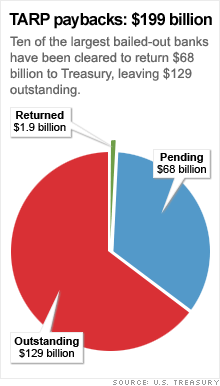Banks still trying to get out of TARP
Many banks remain stuck in the controversial program. But they will have to raise capital and post better results before they'll be allowed to exit TARP.

NEW YORK (CNNMoney.com) -- A flurry of banks officially escaped the clutches of TARP after cutting checks to the U.S. government Wednesday, marking the first major payback of the billions of dollars in aid invested in banks last fall.
Still, hundreds of lenders, including industry leaders Bank of America (BAC, Fortune 500) and Citigroup (C, Fortune 500), remain under the government's thumb, leaving many banks to cope with life inside the confines of the Treasury Department's controversial Troubled Asset Relief Program.
Banks have been working particularly hard to break free from TARP for several months now, decrying the various restrictions that have come with government aid, including restrictions on compensation for executives and other top earners.
But regulators have conceded little, fearing that many banks may be ill-equipped to withstand another bout of economic turmoil in the months ahead. There have also been concerns that banks may scale back on lending after returning TARP funds.
Small and mid-sized lenders, many of whom were strongly encouraged by regulators to participate in the program shortly after its launch last fall, have been met with some resistance in the application process, said David Katz, a partner in the financial markets practice at Orrick, Herrington & Sutcliffe.
"I think a lot of those institutions are very upset and unhappy," he said. "They have not been told no, but [regulators] are not moving very quickly."
Before last week's announcement, only about two dozen banks, mostly community-based lenders, have won approval to redeem preferred shares the government acquired last fall. That represents nearly $1.9 billion in taxpayer money.
At the other end of the spectrum, the ten financial firms that were approved to exit TARP last week, including JPMorgan Chase, Goldman Sachs and American Express, are poised to return a combined $68 billion in funds to the Treasury.
But some large lenders have opted not to apply to pay back money just yet, including Pittsburgh-based PNC (PNC, Fortune 500) and Wells Fargo (WFC, Fortune 500), two companies that have been widely recognized as two of the nation's healthiest banks.
While the pair have cited acquisitions of rivals made late last year and the tough economic climate for remaining within the program, it is clear that both banks, and others, will have to raise capital in excess of what was required by the government's stress-test program to win their freedom from TARP.
Wells Fargo, which has publicly groused about the program as well as the stress tests, had hoped to rely, in part, on the bank's revenue power to fix its $13.7 billion capital shortfall, said Raymond James analyst Anthony Polini.
But after consistently sparring with regulators over the past 10 months, the San Francisco-based banking giant is quietly acquiescing instead, choosing to earn its way out of TARP in a matter of months. Wells received $25 billion in TARP funds last fall.
"I think Wells is just getting a little tired of the process," said Polini. "The bottom line is it will probably be easier if it can put two solid quarters under their belt."
PNC, having already filled its $600 million capital shortfall, could follow closely behind, although some analysts suspect it may not pay back the $7.6 billion in TARP funds it received until some time in 2010.
Experts suggest that other big recipients of government aid, including SunTrust (STI, Fortune 500), Huntington Bancshares (HBAN) or Marshall & Ilsley (MI), are likely candidates to emerge from TARP in the near future. These three regional banks, which took hold of a combined $8 billion in government aid, have successfully managed to raise capital in the last month.
Some even think Bank of America (BAC, Fortune 500), which was required to raise nearly $34 billion, by far the most strained of the 19 big banks tested, is poised to earn its freedom from the program. BofA chief Ken Lewis has said publicly in recent months that he is anxious to return money to U.S. taxpayers.
The bank has already raised nearly all of the capital mandated by regulators. And if its controversial purchases of Merrill Lynch and Countrywide continue to bolster the company's bottom line, much as they did in the first quarter, the bank could soon be allowed to pay back the $45 billion in government aid it has taken in since last fall.
"Despite all the questions raised about Bank of America, if management makes it a priority, they will find a way," said Linus Wilson, an assistant finance professor at the University of Louisiana at Lafayette.
The timetable for rival Citigroup to exit TARP however, remains a bit more cloudy.
Speaking at a forum Monday hosted by CNNMoney.com parent Time Warner, Citi chairman Richard Parsons said that the embattled bank planned to pay back the roughly $50 billion in government assistance it has received. But he was unable to provide a timetable for doing so.
As part of the repayment process, banks have to prove to both the Treasury Department and their respective regulator that they will remain well capitalized and will continue to lend after returning TARP funds. One additional stipulation is that banks must be able to issue debt without government assistance.
Most experts doubt, however, that regulators will impose stricter standards on banks that want to exit TARP in the future -- assuming, of course, that banks do not hit another rough patch.
"It might actually be easier," said Raymond James' Polini. "But it depends on the economy." ![]()

